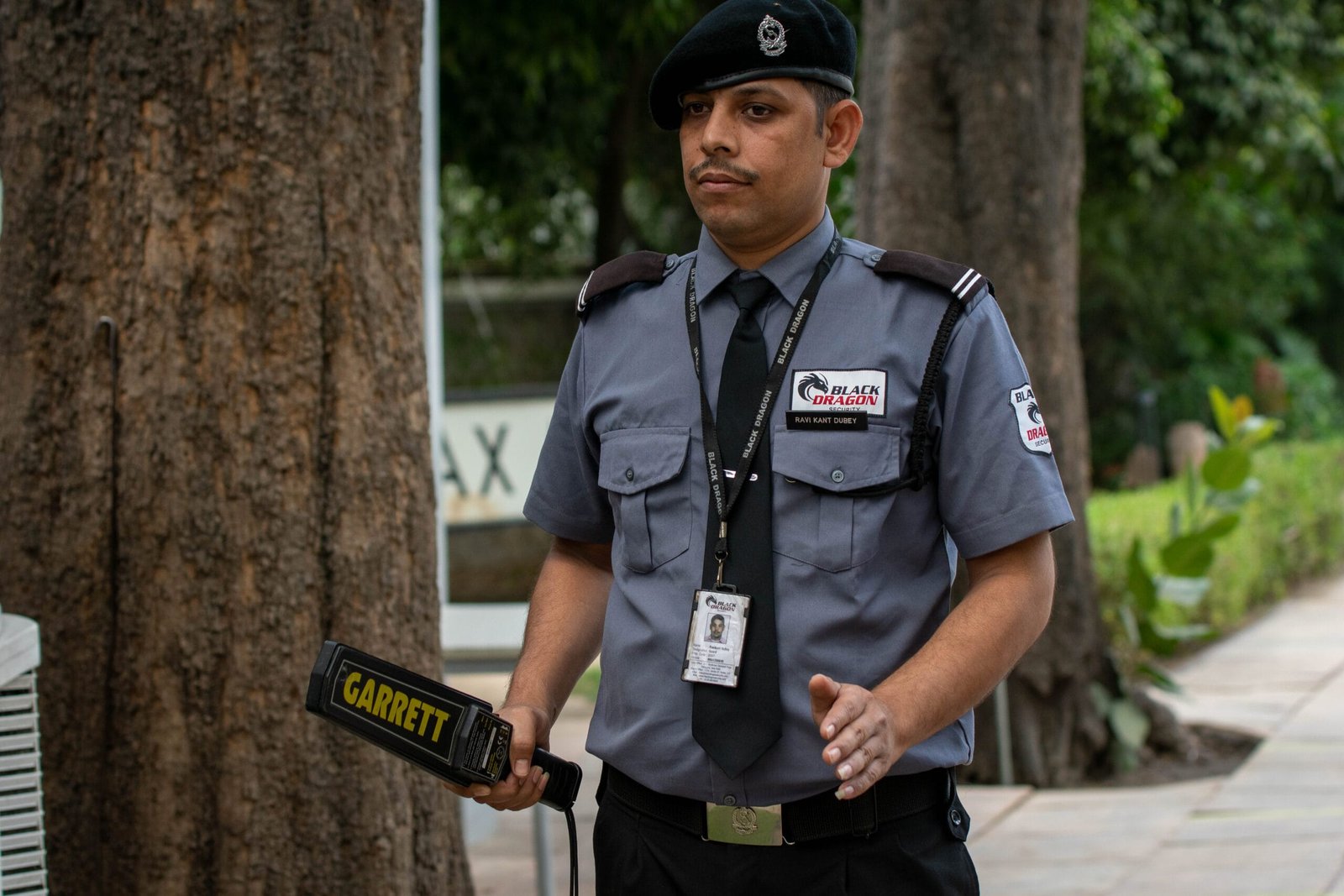Hiring the right number of security guards is one of the most important decisions for any business. Too few guards, and your premises become vulnerable. Too many, and you end up overspending without real need. Yet in Delhi and Noida, businesses are often unsure of the correct guard strength because most agencies do not explain how manpower is actually calculated.
This guide solves that problem.
Below is an easy-to-understand, practical method to calculate how many security guards your office, hotel, warehouse, or residential property truly needs — based on entry points, risk level, shift pattern, and actual on-ground requirements. If you’re planning to hire security services in Delhi or Noida, this resource will help you make an informed, professional decision.
Why Guard Strength Matters More Than You Think
Most incidents — theft, trespassing, fire mishandling, unauthorized access, and vandalism — don’t happen because guards are untrained. They happen because the guard strength is wrong.
Common consequences of poor manpower planning:
- One guard is forced to manage two gates — leaving blind spots.
- No patrolling guard means incidents go unnoticed at night.
- No supervisor = no accountability, poor reporting, and mismanagement.
- No backup guards during breaks or lunch → gate left unmanned.
- Understaffing increases guard fatigue, leading to mistakes.
A professional deployment plan prevents these failures. Let’s break down the inputs needed to calculate manpower properly.
The 3 Key Inputs Needed to Calculate Guard Manpower
Before calculating numbers, you must identify three simple inputs.
1. Number of Entry & Exit Points
Every gate requires attention. A “gate” can be:
- Main entry
- Staff entrance
- Basement parking entry
- Loading bay
- Service gate
- Fire exit used for deliveries
- Emergency gate
Rule:
Each active gate requires minimum 1 guard per shift, and high-traffic gates require more.
2. Risk Level of the Property (Low / Medium / High)
Risk level depends on:
- Footfall
- Crowd profile
- High-value assets present
- Crime trends in the area
- Night operations
- VIP movement
- Cash handling
- Past incidents
Examples:
- High-end hotels = high risk
- Warehouses with expensive stock = high risk
- IT offices with 24×7 operations = medium-to-high
- Small offices with daytime staff only = low-to-medium
Higher risk requires more patrolling, more gate control, and stronger supervision.
3. Shift Pattern (8-hour or 12-hour shifts)
Most Delhi & Noida sites operate on 12-hour shifts, meaning:
- 2 shifts per day
- 1 guard covers half the day
- 2 guards are required to cover 24 hours (for that position)
However, if the client prefers 8-hour shifts, guard count increases by 50%.
Standard Guard Deployment Formula (Simple & Reliable)
Once the above inputs are clear, manpower requirements can be estimated using this standard approach used in professional security planning.
For Each Gate:
- Low Risk: 1 guard per shift
- Medium Risk: 1 guard + 1 support guard during peak hours
- High Risk: 1 guard + 1 patrolling guard + 1 backup in peak hours
For Internal Patrol:
- Offices: 1 patrolling guard per 25,000–30,000 sq ft
- Warehouses: 1 patrolling guard per 15,000–20,000 sq ft
- Hotels: Patrolling at each floor zone or service corridor every 30–45 mins
For Access Control / Reception:
If guards manage visitor logs, ID scanning, or parcel handling:
- Add 1 guard at reception or lobby desk
- Add 1 guard at back-office or staff entry
For Supervisor Requirement:
A supervisor ensures discipline, attendance, audit checks, reporting, and liaising with management.
Ratio:
1 supervisor per 8–12 guards
Weekly Off / Leave Relief Factor:
To ensure there are no gaps due to weekly offs:
- Add 15–20% relief guards to total manpower
- This is ignored by cheap, unprofessional agencies — leading to absenteeism
Step-by-Step Method to Calculate Total Manpower
Here is the exact method used by professional agencies like Black Dragon Security.
Step 1 — Identify all entry/exit points
Make a list:
- Main gate
- Staff entry
- Basement entry
- Loading/unloading bay
- Service gate
- Reception
- Fire exit (if used operationally)
Step 2 — Determine risk level
Mark the risk for each zone:
- High risk: hotels, warehouses, banks, VIP offices
- Medium risk: IT offices, corporate towers
- Low risk: small offices, low-footfall properties
Step 3 — Calculate manpower per shift
Apply the guard-per-gate formula:
- Gate guards
- Patrol guards
- Reception guards
- Control room (if CCTV is used)
Step 4 — Multiply by number of shifts
For 12-hour shifts:
- Multiply by 2
For 8-hour shifts: - Multiply by 3
Step 5 — Add supervisor(s)
Depending on total guard strength.
Step 6 — Add 15–20% relief
For weekly offs, sick leave, emergencies.
Once this is done, you get the correct guard strength for your property.
Sample Calculation 1: Corporate Office (50,000 sq ft, Delhi)
Scenario Details
- 1 main gate
- 1 staff entry gate
- 1 basement parking entry
- Medium-risk profile
- 50,000 sq ft area
- 12-hour shifts
Step 1 — Gate Requirements
- Main gate → 1 guard
- Staff entry → 1 guard
- Basement entry → 1 guard
Total = 3 guards per shift
Step 2 — Patrol Requirement
Office: 1 patrol per 25,000 sq ft
- 50,000 sq ft → 2 patrol guards needed per shift
Step 3 — Reception Desk
If the office expects visitors:
- Add 1 reception security guard
Total per shift = 6 guards
For 24 hours (2 shifts):
6 × 2 = 12 guards
Step 4 — Supervisor
For 12 guards → 1 supervisor
Step 5 — Add 20% Relief
(12 + 1 supervisor) × 20% ≈ 3 relief guards
✅ Total Guard Strength = 15–16 guards
Sample Calculation 2: Mid-Sized Hotel (120 Rooms, Noida)
Scenario Details
- High footfall
- VIP movement
- 1 main porch
- 1 service gate
- 1 staff entry
- 1 basement entry
- CCTV control room
- High-risk profile
Step 1 — Gate Posting
- Main porch → 2 guards
- Service gate → 1 guard
- Staff entry → 1 guard
- Basement entry → 1 guard
Total = 5 guards per shift
Step 2 — Patrol Coverage
Hotels require patrolling on:
- Lobby
- Guest floors
- Service corridors
- Parking
- Perimeter
At least 2 patrolling guards per shift
Step 3 — Lobby & Reception
- 1 lobby guard
- 1 luggage screening guard (if applicable)
Step 4 — CCTV Control Room
- 1 trained guard per shift
Total per shift = 9 guards
For 24 hours:
9 × 2 = 18 guards
Step 5 — Supervisor
1 supervisor per shift
Step 6 — Relief
(18 + 1 supervisor) × 20% ≈ 4 relief guards
✅ Total Guard Strength = 22–23 guards
Sample Calculation 3: Warehouse / Logistics Facility
Scenario Details
- 2 loading bays
- 1 main gate
- High-value inventory
- Frequent truck movement
- High-risk theft environment
- Night operations
Step 1 — Gate Posting
- Main gate → 2 guards (documentation + physical check)
- Loading bay 1 → 1 guard
- Loading bay 2 → 1 guard
Total = 4 guards per shift
Step 2 — Patrol
Warehouses need tighter patrol:
- 2 patrolling guards per shift
Total per shift = 6 guards
For 24 hours:
6 × 2 = 12 guards
Step 3 — Supervisor
1 supervisor per shift
= 2 supervisors for full day
Step 4 — Relief
(12 + 2 supervisors) × 20% ≈ 3 guards
✅ Total Guard Strength = 17 guards
When Should You Deploy Additional Manpower?
Certain properties or situations require additional or specialized manpower.
Consider adding more guards when you have:
- High-value stock or cash
- VIP movement
- Large footfall (hotels, malls, corporate events)
- Multi-floor operations with multiple access points
- Fire safety responsibilities
- Vehicle checking (undercarriage mirror, boot check)
- Bag checking & metal detector use
- Emergency drills or crowd management events
Additional specialized guards ensure smoother operations and reduced risk.
Common Mistakes Businesses Make in Guard Deployment
Avoid these errors — they are the biggest causes of security failures.
1. Understaffing the gate
One guard managing two gates = guaranteed blind spots.
2. No patrolling guard
Incidents occur in basements, backyards, blind corridors.
3. No supervisor
No discipline, no reporting, no accountability.
4. No relief staff
Gate becomes unmanned during lunch or sick days.
5. Wrong shift pattern
Using 12-hour guards for high-footfall environments leads to fatigue.
6. No night-specific plan
Nighttime requires stricter patrol and double-checks.
Free Download: Guard Strength Calculator (PDF/Excel)
To help you plan manpower more accurately, you can get a free Guard Strength Calculator designed specifically for:
- Offices
- Hotels
- Warehouses
- Residential complexes
It allows you to input gate count, risk level, patrol area, and shift system — and it instantly suggests the correct number of guards.
Conclusion: Get a Custom Guard Deployment Plan for Your Property
Every property is unique. A one-size-fits-all approach doesn’t work for security.
If you want the exact guard strength for your:
- Office
- Hotel
- Warehouse
- Factory
- Residential society
Black Dragon Security provides a free site survey and risk assessment for businesses across Delhi & Noida.
A correct deployment plan protects your assets, ensures smooth operations, and reduces long-term costs.



